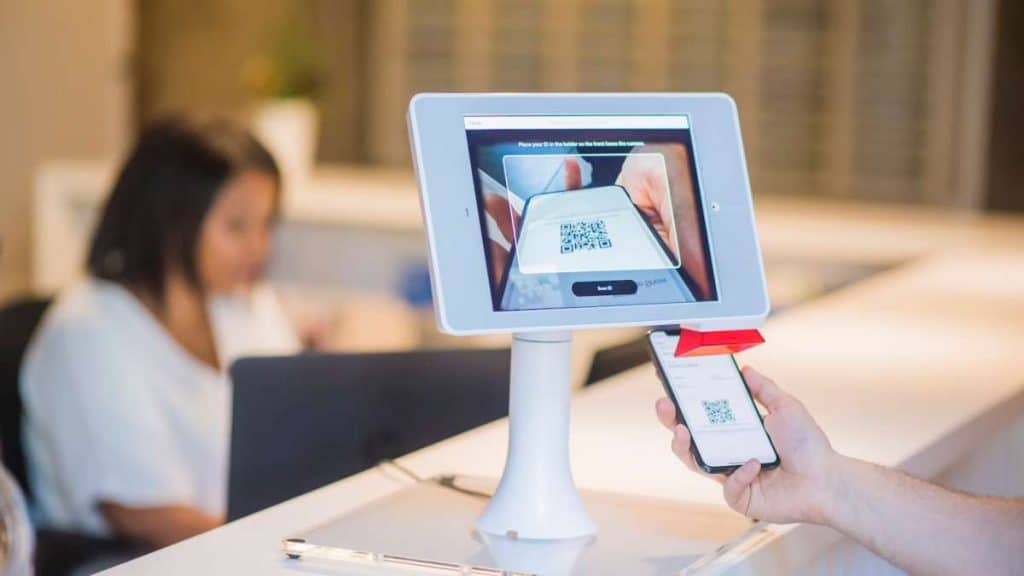A visitor management system, or VMS, is any tool that helps a business keep track of the people who come to see them. It’s the first thing that people outside of the company see when they interact.
Gone are the days of maintaining ledgers and Excel sheets for the incoming public. Now, everything is digitally documented, shared, and updated. Moreover, a visitor (maybe a job prospect or an investor) can do the “check-in” even before setting foot on the company’s property.
This streamlining of incoming traffic has been made possible by cutting-edge VMS developments. Let us check out four such amazing trends that have benefited workplaces tremendously.
AI-Powered Visitor Screening and Risk Assessment
When coupled with artificial intelligence (AI), visitor management software becomes extremely robust with customer verifications. Upon a visitor’s check-in, the AI-VMS system can retrieve pertinent details from their ID.
This data set can be used in several compliant ways. According to Greetly, the photo and the name can be cross-checked against a database of pre-registered visitors. It is like a guest list, only the ones who have appointments are allowed entry.
Another gripping application for cross-verifying a visitor’s profile is running the data against security threats, such as government watchlists, and criminal records.
When a match is detected, the system promptly notifies concerned security managers. This process is highly efficient and precise, as artificial intelligence allows for rapidly processing large volumes of data, ensuring that no known threats go unnoticed.
AI algorithms are trained on vast datasets and can analyze visitor behavior patterns extensively. Your VMS can then identify anomalies in a visitor’s conduct. Unusual check-in times or erratic movement patterns on the premises can be detected by motion sensors. These help the system pinpoint behaviors that stray from the norm. This enables proactive risk mitigation and prevents potential security breaches.
Contactless and Self-Service Check-In
The COVID-19 pandemic has completely transformed our perspective on hygiene and sanitization. Wherever possible, human interaction and touch have been kept to a minimum, with workspaces adopting contactless and self-service check-in solutions. These continue to be used even after the pandemic.
In addition to keeping the employees safe, this method enhances the visitor’s user experience. An important development in this field is the increasing popularity of mobile pre-registration and check-in.
Guests now have the convenience of completing the entire check-in process using their smartphones. This eliminates the need for any face-to-face interactions with reception staff and makes the check-in process more efficient. Moreover, it decreases wait times and improves the overall visitor experience.
Moreover, just like the new-age airports, many office receptions now have self-check-in kiosks with touchless interfaces. These cutting-edge kiosks incorporate technologies, like facial recognition and QR scans, to ensure a smooth and hygienic check-in experience.
Integration with IoT
The Internet of Things has transformed visitor entry and overall experience, the moment they step inside an office building. One prime example of IoT integration in VMS is the use of smart badges equipped with Radio Frequency Identification (RFID) or Near Field Communication tags.
These badges connect with IoT-enabled readers strategically positioned throughout the building, enabling precise access control and live visitor monitoring. The VMS can then employ complex machine-learning algorithms to detect any potential security threats or unauthorized access attempts.
In addition, IoT sensors can gather important data regarding the building environment and visitor behavior. These sensors include occupancy sensors, temperature sensors, and light sensors. Through the integration of this data with the VMS, businesses can optimize space utilization and energy consumption.
Personalized Visitor Experiences
Everyone likes personalized shopping offers and discounts, right? Moreover, you are more likely to engage in an email chain, if it is specifically designed for your grievances and issues.
Humans crave attention and this is not any different for people coming to your office space. They want to feel important from the time they set foot on your premises. Integrating VMS with customer relationship management (CRM) systems can be a game-changer for creating personalized visitor experiences.
By synchronizing visitor data across these systems, a business can obtain a comprehensive understanding of each visitor’s profile. This data can be utilized to initiate personalized email communications, targeted content recommendations, and customized check-in processes.
For example, when a VIP visitor checks in, the VMS can instantly recognize their status and initiate a specialized welcome protocol. This may include alerting relevant stakeholders and displaying personalized greetings on digital signage.
To sum up, with the ever-increasing focus on security and efficiency, it has become crucial for businesses to invest in a state-of-the-art VMS. This investment not only becomes a necessity but also provides a strategic advantage in the fast-paced environment of the contemporary workplace.
